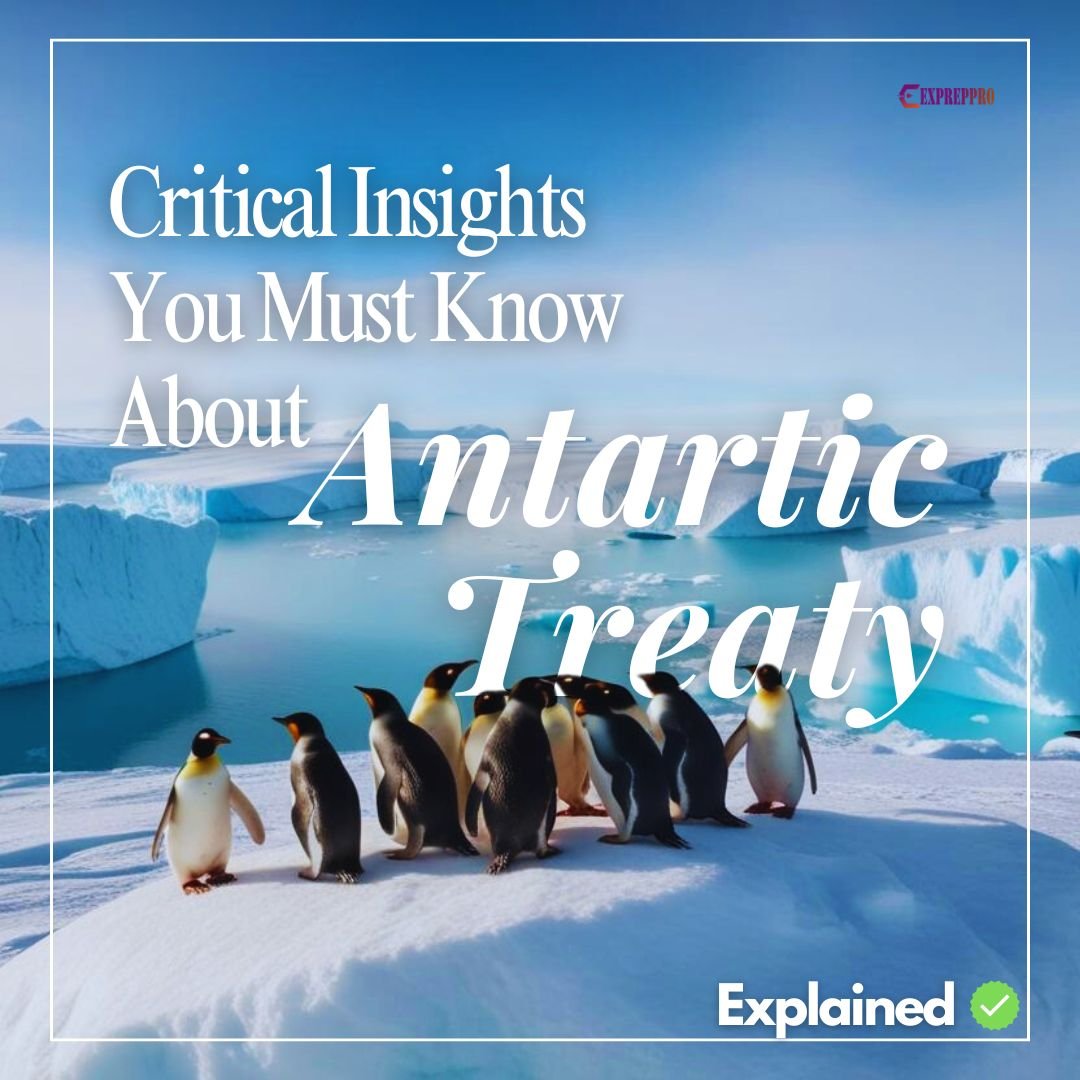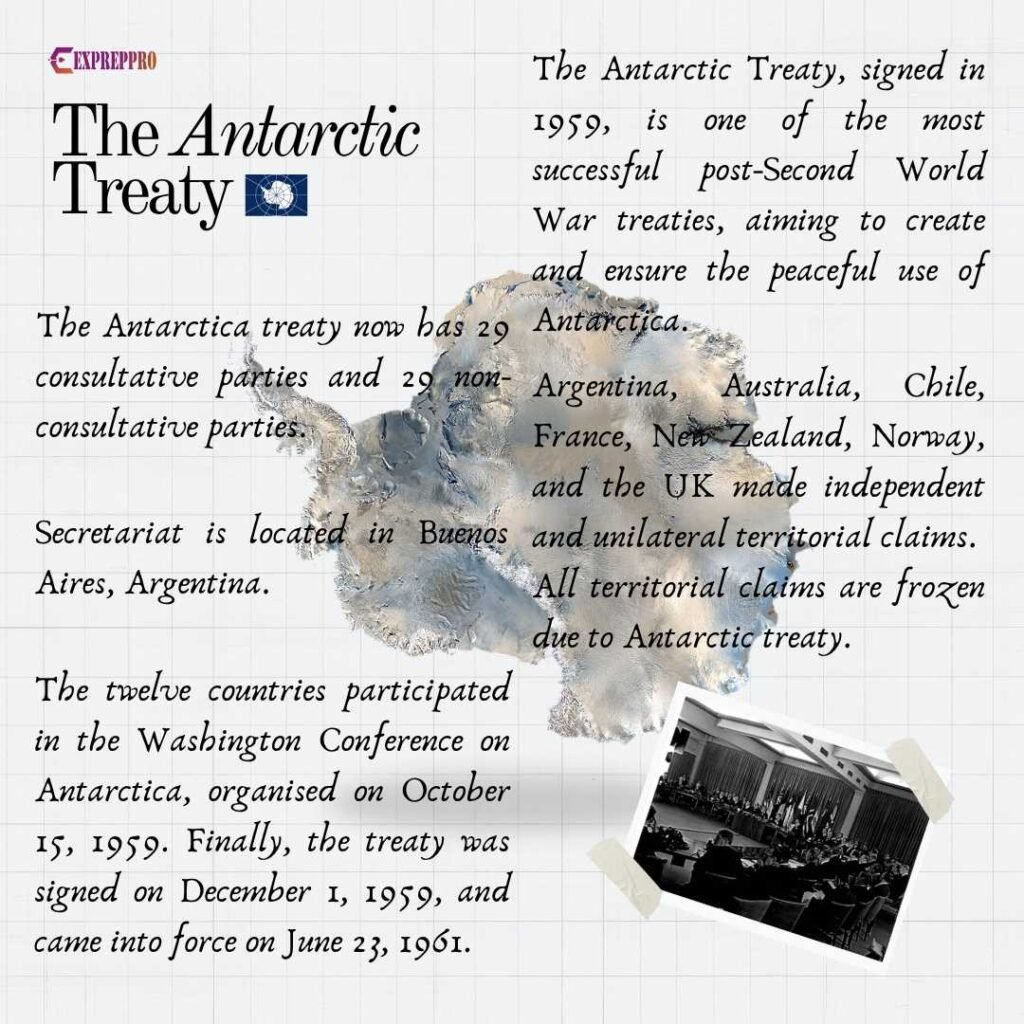
The Antarctic Treaty, signed in 1959, is one of the most successful post-Second World War treaties, aiming to create and ensure the peaceful use of Antarctica. The Antarctic Treaty was signed in Washington on December 1, 1959, by 12 countries, covering an area of 14 million square kilometres for the common good of humanity.
An overview of Antarctica
Antarctica is a continent, and in fact, it is the highest, driest and coldest continent in the world. In short, it is a daunting content. According to the Antarctic Treaty, the Antarctic region is the area south of the 60° south latitude.
The total landmass is about 14 million square kilometres on and around the geographical south pole. It takes up nearly one-tenth of the terrestrial world.
About 98 to 99 % of the area is covered with an ice sheet 2000-4000 meters thick. Even volcanoes and high mountains are covered by snowfields and glaciers.
Antarctica is divided into two main geographical regions.
- East Antarctica
- West Antarctica

Territorial Claims On Antarctica
The fifth continent has no indigenous population, and no country owns Antarctica. But in the 20th century, many world powers and countries made territorial claims on the Antarctica region.
Seven countries made independent and unilateral territorial claims. Argentina, Australia, Chile, France, New Zealand, Norway, and the UK are the seven countries. All claims were made between 1904 and 1940. Argentina was the first one to claim Antarctica, and Chile was the last.
Only three countries claim overlapped. Argentina, Chile, and the UK made these overlapping claims. The UK claims cover the entire area of Argentina and a large part of Chile’s area.
Out of the five countries in the closest geographical proximity to Antarctica, South Africa was the only one not to raise any official claim. Even Norway made a claim based on their early presence in the area.
Japan once claimed Antarctica but later renounced all its claims after signing the Treaty of Peace in San Francisco on September 8, 1951.
To secure their position, on March 4 1948, Argentina and Chile made a joint declaration on Antarctica called the Vergara Donoso-La Roza Declaration. In this declaration, they pleaded to act in common accord in the juridical protection and defence of their right in South American Antarctica.
To avoid military conflict in the region, the UK, Argentina and Chile agreed to a Tripartite Naval Declaration on January 8, 1949.
Skirmishes For Antarctica
Soon after the Second World War, these claims became serious and resulted in confrontations.
For example, the UK warship HMS Carnarvon Castle’s crew removed the commemorative plaques installed in 1942 by the Argentinian expedition to the Deception and Weckie islands.
In 1948, the then-president of Chile, Mr Gabriel Videla, said, “Defend the sovereignty and unity of our country from Africa to the South Pole”.
Later, in 1952, Argentinian armed forces in Hope Bay opened fire on a British expedition and attempted to reoccupy a state. In 1953, the UK forcefully dismantled Chilean and Argentinian installations on Deception Island and arrested two Argentinians.
In 1952, the UK referred a dispute to the ICJ (International Court of Justice) against Chile and Argentina. According to the UK government, Chile and Argentina have encroached on their territories located south of the 50th parallel of the south latitude. Since neither Argentina nor Chile recognised the ICJ, the case was discontinued in 1956.
No other countries, including the United States and the Soviet Union (now Russia), accept these claims. In 1939, US President Mr Franklin D. Roosevelt said, “The United States has never recognised any claims to sovereignty over territory in the Antarctic regions asserted by any foreign state. No member of the United States Antarctic Service shall take any action or make any statements tending to compromise this position“.
Now, the world, especially the USA, has considered various approaches, such as UN trusteeship, to address this issue.
Four Major Types of Conflicts Happened in Antarctica
- Local disputes about territory claims.
- General disputes about claims prompting broader international action.
- Conflicts about strategic uses of the area.
- Rivalries between political superpowers at the general international level.
Escudero Proposal or Escudero Declaration
Both Argentina and Chile denied the US idea of trusteeship. The Chilean response included a proposal. Now, it is known as the Escudero Declaration or proposal.
According to this declaration
- Chile rejected the condominium scheme.
- Governments could establish scientific bases.
- Can undertake scientific expedition-associated activities.
- The declaration applies to all territory south of 60° south latitude.
- This proposal will remain in effect for a period of five years.
- A five-year moratorium on territorial claims.
The Escudero declaration didn’t create an immediate change, but later, it became the key idea for the Antarctic treaty. It contained the elements of the final solution to the claims issue found in Article IV of the Antarctic Treaty.
India’s Intervention in UN
India tried to include the turbid situation in Antarctica on the 1956 UNGA agenda. The intention was to find a solution, but Chile and Argentina pressured India not to bring an issue to UNGA.
Again, in 1958, India tried to include Antarctica on the UNGA agenda for the prevention of uncontrolled mining of resources. Later, it was withdrawn because of the advanced state of preparation for the Washington Conference on Antarctica. The conference resulted in the Antarctica Treaty.
Chile and Argentina considered their Antarctic claims to be an internal matter related to their national domain. So, the UN discussion on the Antarctica affair is a violation of Article 2, Paragraph 7 of the UN Charter. This section prevents the UN from intervening in the affairs of member states.
International Geophysical Year, 1957-1958
Many scientists like Dr Lloyd Berkner of the Carnegie Institute (USA) favoured a third polar year. The first two, 1882-3 and 1932-33, concentrated on the North Pole. Now, researchers would like to focus on the South Pole.
The plan was developed through ICSU, and the third International Geophysical Year commenced on July 1, 1957, and ended after 18 months on December 31, 1958.
Around 67 countries were involved, whereas, in Antarctica, only 12 countries conducted research with their 55 base stations. Argentina, Australia, Belgium, Chile, France, Japan, New Zealand, Norway, the Union of South Africa, the USSR, the United Kingdom, and the United States of America were the countries that participated in Antarctic research.
What Made the Final Antarctic Treaty and How It Was Signed?
The Australian government feared that after the IGY, the Soviet Mirny base would be converted into a submarine base. The base was built in Australia’s claimed territory in Antarctica. So, nations need to avoid the militarisation of this icy continent and further escalation of tensions.
To find a solution, the countries participated in IGY Antarctic research and agreed to participate in a conference. The conference was based on 3 points of agreement that had been reached in informal discussions.
- Demilitarization of Antarctica.
- The legal status quo of the Antarctica continents remains unchanged.
- Scientific cooperation for research.
- Use of Antarctica for peaceful purposes.
- The twelve countries participated in the Washington Conference on Antarctica, organised on October 15, 1959. Finally, the treaty was signed on December 1, 1959, and came into force on June 23, 1961.
Major Provisions of the Antarctic Treaty
- It will be used for peaceful purposes only (the military may be involved in logistical support).
- Territorial claims are frozen.
- Can conduct scientific research.
- Free exchange of research results.
- Nuclear waste and explosives are banned.
- All bases are open to inspection by any treaty nation at any time. ( Argentina, Australia, New Zealand, the USSR, the UK and the USA have all exercised the right of inspection.)
- It covers all areas south of 60° south latitude.
Total Number Of Members
The Antarctica treaty now has 29 consultative parties and 29 non-consultative parties. Non-consultative parties can attend consultative meetings, but they cannot participate in the decision-making process.
Originally, 12 countries that signed the treaty were considered consultative parties; however, others have been added to cover the “substantial research activity.”
Antarctic treaty members included over 70 per cent of the world population.
South Africa was not a territory claimant, but due to their research activities in Antarctica, they were invited to the conference.
Secretariat Of Antarctic Treaty
During the early days, the Antarctic Treaty had no permanent secretariat; however, a consensus was reached in July 2001 (Consensus 1). Today, its secretariat is located in Buenos Aires, Argentina.
The government of Argentina provides the office for the headquarters and the secretariat. The secretariat is funded by the consultative parties to the treaty, and the budget is decided at the ATCM or Annual Antarctic Treaty Consultative Meeting.
Meetings of ATCM
The 46th Antarctic Treaty Consultative Meeting and the 26th meeting of the Committee for Environmental Protection took place from May 20 to May 30, 2024, in Kochi, India.
The organisers scheduled the next ATCM meeting in Milan, Italy, from June 23 to July 3, 2025.
What is the Antarctic Treaty System?
The Antarctic Treaty and its associated instruments comprise the Antarctic Treaty System. These include
- Convention for the Conservation of Antarctic Seals (adopted on June 1, 1972).
- Convention on the Conservation of Antarctic Marine Living Resources or CCAMLR ( adopted at Canberra on May 20, 1980).
- Protocol on Environmental Protection to the Antarctic Treaty or Environmental Protocol.
Major Articles
Article 1:
Antarctica shall be used for peaceful purposes only. Nuclear weapons are prohibited, but the military can take part in logistical support or other peaceful purposes.
Article 2:
Freedom of scientific investigation and cooperation in Antarctica.
Article 3:
Contracting parties should share information regarding plans for scientific programs, scientific personnel, and scientific observations and results from Antarctica.
Article 4:
The Treaty didn’t renounce the existing territorial claims. This is a classic example of true diplomacy because the treaty protects the positions of both claimant and non-claimant states, as well as the positions of the United States and Russia, which reserved their basis of a claim.
Article 5:
Any nuclear explosions in Antarctica and the disposal there of radioactive waste material shall be prohibited.
Article 6:
The provisions of the present Treaty shall apply to the area south of 60° South Latitude, including all ice shelves, but nothing in the present Treaty shall prejudice or in any way affect the rights, or the exercise of the rights, of any State under international law concerning the high seas within that area.
Article 7:
The Contracting Party whose representatives are entitled to participate in the meetings referred to in Article IX of the Treaty shall have the right to designate observers to carry out any inspection provided for by the present Article. Observers shall be nationals of the Contracting Parties which designate them.
Article 8:
Addresses jurisdiction within Antarctica, explicitly focusing on observers, scientific personnel, and their staff.
Article 10:
Contracting Parties undertake to exert appropriate efforts, consistent with the Charter of the United Nations, to the end that no one engages in any activity in Antarctica contrary to the
principles or purposes of the present treaty.
Article 11:
If any dispute arises between two or more of the Contracting Parties concerning the interpretation or application of the present Treaty, those Contracting Parties shall consult among themselves with a view to having the dispute resolved by negotiation, inquiry, mediation, conciliation, arbitration, judicial settlement or other peaceful means of their own choice. If not solved, it will be referred to ICJ.
Article 14:
The present treaty, done in the English, French, Russian and Spanish languages, each version being equally authentic, shall be deposited in the archives of the Government of the United States of America, which shall transmit duly certified copies thereof to the governments of the signatory and acceding states (with the consent of parties).



